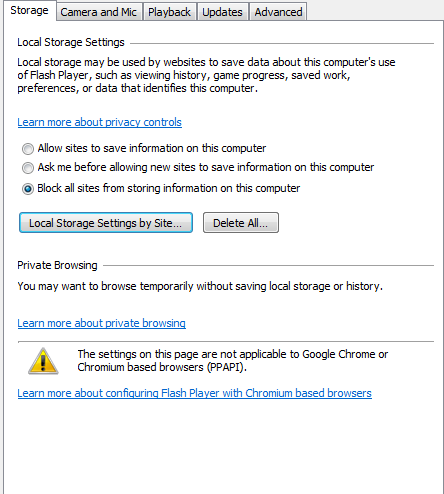 Adobe Community
Adobe Community
Copy link to clipboard
Copied
Environment:
Windows 7 Pro SP1 64-bit
Internet Explorer 11
Adobe Flash Player 26.0.0.151/27.0.0.130
We're trying to set up mms.cfg settings to be the equivalent of the following settings in the Local Settings Manager.
For Local Storage Settings - "Block all sites from storing information on this computer"
For Camera and Microphone settings - "Block all sites from using the camera and microphone" (We think AVHardwareDisable=1 is correct for this setting)
For Peer-assisted Networking - "Block all sites from peer-assisted networking". (We think RTMFPP2Disable=1 is correct for this setting)
So, what are the equivalent mms.cfg settings to mimic the Local Storage Settings "Block all sites from storing information on this computer"? We've done extensive testing with the Local Storage "Block" setting and it works well for us. We would like to migrate the equivalent to the mms.cfg file for administrative purposes.
 1 Correct answer
1 Correct answer
The System Administrator's Guide has a nice comprehensive reference of these settings:
LocalStorageLimit=1 should prevent the storage of Local Shared Objects. What behavior are you observing that indicates that this flag isn't being honored? (As you've pointed out, "storing information" is definitely vague.)
Also, are you sure that mms.cfg is installed in the right location? T
...Copy link to clipboard
Copied
Hi,
For Disable Local Storage, use LocalStorageLimit=1
The other 2 options you have are correct:
For Disable Camera Microphone, use AVHardwareDisable=1
And for, Disable Peer-assisted Networkding, use RTMFPP2Disable=1
--
Maria
Copy link to clipboard
Copied
Thank you for your response. It seems to me that LocalStorageLimit affects the settings shown below.

versus

It would be reasonable to assume that if you set LocalStorageLimit=1 (no storage) then that would block all sites from storing information on the client. I guess it all hinges on what "storing information" means - that's not very specific.
Please see the comments in mms.cfg LocalStorageLimit options
According to that thread, LocalStorageLimit=1 didn't prevent sites from storing on the local machine.
Is the proposed solution of ThirdPartyStorage setting of '0' and a LocalStorageLimit of '0' incorrect? I don't see a "0" setting for LocalStorageLimit in the Admin Guide.
Copy link to clipboard
Copied
The System Administrator's Guide has a nice comprehensive reference of these settings:
LocalStorageLimit=1 should prevent the storage of Local Shared Objects. What behavior are you observing that indicates that this flag isn't being honored? (As you've pointed out, "storing information" is definitely vague.)
Also, are you sure that mms.cfg is installed in the right location? The system administrator's guide has details on pp.24 that might be more up-to-date.
It *is* probably worth pointing out that the settings you change in mms.cfg don't update the UI. If you're looking to see whether or not the settings changed, that's not going to help you validate that the flag is in effect. You'd have to actually test it against some functionality and observe the correct behavior.
Copy link to clipboard
Copied
We apologize for the lengthy delay in responding.
Thanks for the update and the comment that "It *is* probably worth pointing out that the settings you change in mms.cfg don't update the UI." Any idea on how to test?
We have a copy of the Sys Admin guide. We know where to place mms.cfg (%WINDIR%\SysWow64\Macromed\Flash) but are a bit puzzled over the format. We're using MS-Notepad to create our custom mms.cfg file, but in what format do we save it? ,txt? or UTF-8 or UTF-16? How do we include the "byte order mark" (what is it?) character at the beginning of the file? We don't see that as an option when saving (or maybe we don't know what to look for). See page 29 "Character encoding".
This is probably really simple, just don't have any experience with creating mms.cfg.
Copy link to clipboard
Copied
You can just create a text file with notepad and rename it to .cfg. Unless you're doing something really esoteric, you shouldn't need to worry about the details.
You'd have to actually look at the filesystem in the location where local shared objects are saved to see if they get created. You could probably just script something to launch the browser, navigate to a test page where you attempt to save a shared object, and then look at the directory to see if it's still empty.
You can find location details here:
Adobe Flash Platform * Shared objects
Similarly, if you were going to restrict camera/mic access, you'd just have to try and access a test page that attempts camera/mic access and ensure that it's dead. It's smarter to test the meaningful outcome than the UI representation anyway. It would be bad if you were checking for the lack of a checkmark as the test, and it was still recording but there was a UI bug. (Hopefully we wouldn't ever do that, but if you're designing redundant tests, better to be skeptical.)
Hope that helps.
Copy link to clipboard
Copied
OK - I think we've got it now...
To do what we want to do:
LocalStorageLimit=1
AVHardwareDisable=1
RTMFPP2Disable=1
Some of the confusion was coming from the fact that the UI doesn't reflect the changes and the wording about UTF-8, UTF-16, and the BOM. We didn't know if Flash was picking up our mms.cfg.
Thanks for the pointers. I suppose that the user can change the setting in the UI but mms.cfg will override. In the future, maybe you can grey out the settings in the UI to better reflect the mms.cfg overrides.
Both you and Maria gave good information.